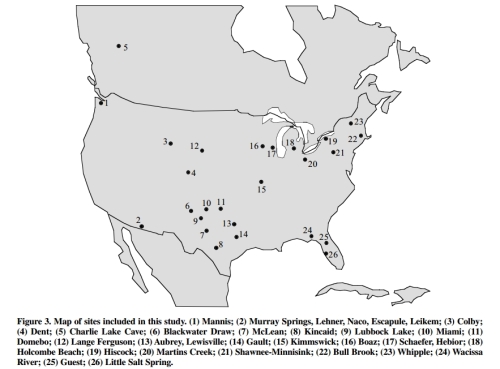In my previous post, Mapping Clovis Man vs Mammoths – Just Asking, I’d asked about the apparent blind spot in Clovis-Mammoth studies. The maps there showed Clovis artifacts VERY predominantly in the Eastern USA, yet amazingly, the only “Clovis sites” chosen for study in Waguespack & Surovell 2003 were sites specifically showing mammoth kills.
Later, in Surovell & Waguespack 2007, the authors say
Using the most lenient and problematic standard of Proboscidean use, simple presence in zooarcheological assemblages, we previously estimated that at least 91 individual mammoths and mastodons are known from a total of 26 Clovis sites (Waguespack and Surovell, 2003, Table 2). Based on available data, no other taxon is present in as many sites or is represented by as many individuals.
My initial problem here has to be their amazing definition of a “Clovis site.” Here, is a different map of artifacts in the USA:
Now, when we read about the Leakeys finding pre-human artifacts in the Olduvai Gorge, the places they are found are normally called “sites” or “digs”. Now maybe Surovell defines sites as some activity, not just a Clovis point. I would heartily disagree. But let’s not quibble too much, because we don’t have to. Look at the map of Clovis artifacts here. Let’s also assume that the website’s authors weren’t stupid enough to just make that map up out of their imaginations. If we go with Surovell’s idea of a “site”, then a stray Clovis point may have been dropped somewhere along a trail, not at a campsite. Still, in a world where all travel is on foot, that dropped point is not going to be more than 20 miles from whatever campsites might be used. By point population alone, it is clear from the map that the careless Clovis hunters were hunting in the regions shown – in both the East and the West. Continue reading




